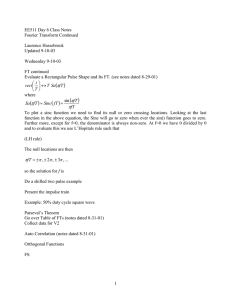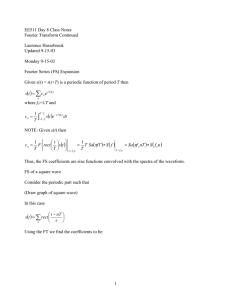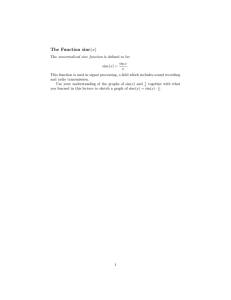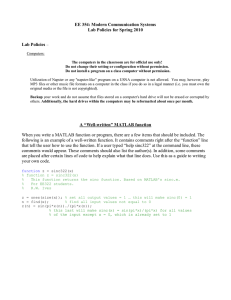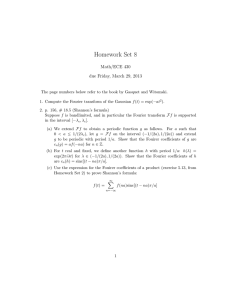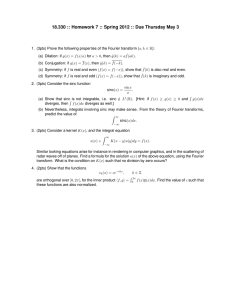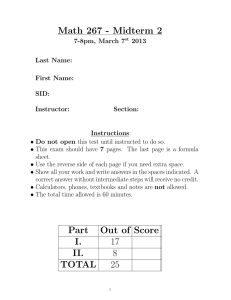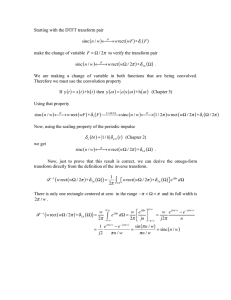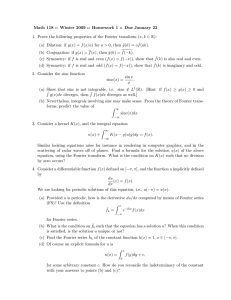Lecture #16
advertisement
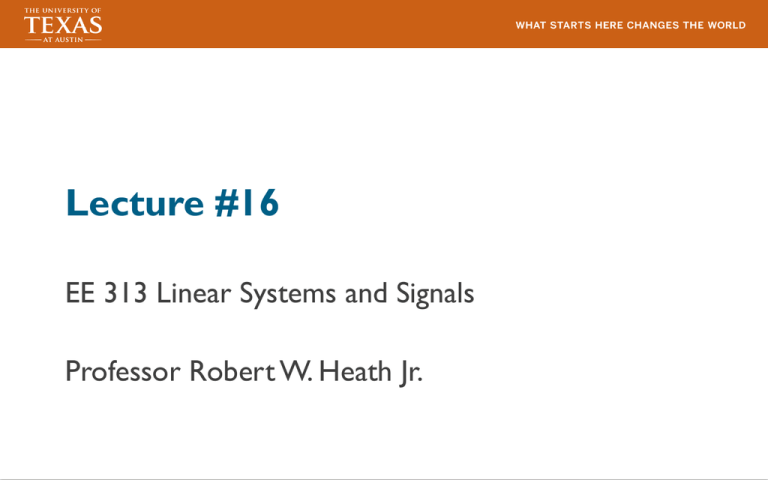
Lecture #16
EE 313 Linear Systems and Signals
Professor Robert W. Heath Jr.
Announcements
u
Homework #8 due this week
u
Midterm #2 is next week
ª Emphasis is on material not covered by Midterm #1
ª Of course there is a significant amount of overlap
ª You can have 2 sheets of paper, handwritten, with notes
ª No calculators, computers, books, etc
ª Material covered is up to and including Lecture #15
2
Preview of today’s lecture
u
Quiz #6 review
u
Brief review
ª Fourier transform definition
u
Sinc and rect functions revisited
ª Explain the duality between sinc and rect functions
ª Highlight the application of sinc and rect to filtering and communications
u
Fourier transform properties
ª Use linearity to calculate the transform of sums of signals
ª Use time shifting to calculate the transform of shifted signals
ª Use differentiation and integration properties
ª Understand the interplay between time and frequency scaling
3
Quiz solution
Key points
o
Define and determine the Fourier transforms of signals
EE313 - Signals and Systems
Quiz # 6
Signals and Systems
No Calculators
Quiz
#6
Name:
Name:
˘
Name:`
ulatorsEE313 - Signals and Systems
⇡
1. (50
of sin 50⇡t ` 3 .
Quiz
# 6points) Determine the Fourier transform
`
˘
ignals
and
Systems
Name:
⇡
´
¯
¯
NoWrite
Calculators
points)
Fourier
transformexponentials
of sin 50⇡t
⇡
⇡ ` 31 .´ j50⇡t`j ⇡
u Determine
in the
terms
of complex
´j50⇡t´j 3
3 ´ e
sin 50⇡t `
“
e
´
¯
´
3 ⇡ 2j
` ⇡¯
˘
ulators 1. (50 points) Determine
⇡ the
1
⇡
j50⇡t`j
´j50⇡t´j
Fourier
transform
of
sin
50⇡t
`
3
sin 50⇡t ` ⇡ “
e ⇡ 3 ´e
3 .
1 3
´1 ´j
` 3 . Therefore
˘ ´ the Fourier transform¯is
FS coefficients are 2j
ej 3 and2j
´
¯
⇡
2j e
points) Determine the
Fourier transform
of sin 50⇡t
⇡ ` 3 1. j50⇡t`j ⇡
´j50⇡t´j ⇡3
3 ´e
1 j ⇡3
´1 ´j ⇡3
sin
50⇡t
`
“
e
coefficients
are 2j e and
e! series
.´Therefore
the Fourier
transform
is
u Determine
Fourier
coefficients
3 1 2j
⇡
⇡ ¯)
1 ´j ⇡
´ 2j
¯
´
¯
j3
⇡
⇡50⇡q ´ 2⇡
F sin⇡ 50⇡t1` j50⇡t`j
“ 2⇡
e
p!
´
e 3 p! ` 50⇡
´j50⇡t´j 3
3 2j
`
“
e
´
e
! ´ sin 50⇡t
¯)
3
2j
⇡
⇡are 1 3ej ⇡3 and
1 2jj ⇡´1 e´j ⇡3 . Therefore1 the
´j Fourier
FS
coefficients
transform is
3
3 p! ` 50⇡q
F sin 50⇡t `
“
2⇡
e
p!
´
50⇡q
´
2⇡
e
2j
2j
3 ⇡
2j
2j
⇡
2.
(50
points)
Consider
a
signal
xptq
that
is
periodic
withis a fundamental period
´j
1 j3
!3. ´
¯)
oefficients are 2j
e and ´1
e
Therefore
the
Fourier
transform
⇡
⇡
1
1 ´j ⇡
2j between Fourier series and
u Use
connection
transform
3is p!
series
coefficients
denoted
by`ak . Let“ zptq
“ejx32Fourier
ptq.
Determine
if zptq
periodi
F
sin
50⇡t
2⇡
p!
´
50⇡q
´
2⇡
eT and
` 50⇡
points) Consider
a
signal
xptq
that
is
periodic
with
a
fundamental
period
of
Fourie
3
2j
2j
! ´
¯) and its
fundamental
period
Fourier
series coefficients
⇡ 2
⇡in terms of ak .
⇡
1“
1if zptq
j
´j
es coefficients
denoted
by
a
.
Let
zptq
x
ptq.
Determine
F sin 50⇡t ` k “ 2⇡ e 3 p! ´ 50⇡q ´ 2⇡ e 3 isp!periodic.
` 50⇡q If so, find th
3
2jcoefficients
2j ak .with a fundamental period
damental period
and its Fourier
series
in terms
of
2. (50 points)
Consider
a signal
xptq that
is periodic
series coefficients denoted by ak . Let zptq “ x22 ptq. Determine if zptq is period
5
zpt ` T q “ x pt ` T q
⇡
1 j⇡
1 ´j ⇡
⇡
⇡
´j
1 j`
´1
3
!
´
¯)
F
sin
50⇡t
“
2⇡
e
p!
´
50⇡q
´
2⇡
FS coefficients are 2j e 3 and
the Fourier transform
⇡ 2j e 3 .2jTherefore
1 j⇡
1e ´j3 ⇡isp! ` 50⇡q
3
2j
F sin 50⇡t `
“ 2⇡ e 3 p! ´ 50⇡q ´ 2⇡ e 3 p! ` 50⇡q
3 ⇡ ¯) 2j 1 ⇡
! ´
12j ´j ⇡
j3
F signal
sin 50⇡t
` that “
2⇡
e
p!with
´ 50⇡q
´ 2⇡ e 3 p!period
` 50⇡q of T and Fourier
points)Quiz
Consider
a
xptq
is
periodic
a
fundamental
3
2j
2j
#6 a signal xptq that is periodic
points)
Consider
with a fundamental
period of IfT so,
andfind
Fourie
s coefficients denoted by ak . Let zptq “ x2 ptq. Determine
if zptq is periodic.
the
2
es
ak . xptq
Let
zptqcoefficients
x ptq. with
Determine
is periodic.
If Fourier
so, find th
2.coefficients
(50 points)
Consider
signal
that
is“periodic
a fundamental
of T and
amental
perioddenoted
and its aby
Fourier
series
in terms
of ifakzptq
. period
series period
coefficients
by ak .series
Let zptq
“ x2 ptq. Determine
if zptq
damental
anddenoted
its Fourier
coefficients
in terms of
ak . is periodic. If so, find the
fundamental period and its Fourier series coefficients in terms of ak .
u
Show it is periodiczpt ` T q “ x22pt ` T q
zpt zpt
` T`q“
x xpt
2 ` Tq
T“
q xpt
“
ptT`qxpt
Tq ` Tq
`
xpt
` TTqq
“
xpt``TTqxpt
qxpt `
““xptqxptq
xptqxptq
“ “xptqxptq
“ x2 ptq
2x2 ptq
“
“
x
“ zptqptq
zptq
“ “zptq
the Fourier
series
coefficients
be bproperty
k
Let
Fourier
series
coefficients
be bk
u the
Use
the
convolution
for a product
the Fourier series coefficients be bk
8ÿ
8
ÿ
8 am
aa
ak´m
bk “bk “ ÿ
mk´m
m“´8a a
bk “m“´8
m k´m
m“´8
of periodic signals
6
Review – Fourier transform definition
Key points
o
o
Define the Fourier transform and its inverse
Use the Fourier transform to perform calculations
ª8
form
1
j!t
xptq
“
Xpj!qe
d!
nsform
ª T {2
2⇡ ´8
1
ª´1xptqe
0t
Summarizing the
transform
its inverse
T {2 ´jk!and
ak Fourier
“xptq “1F
dt
tXp!qu ´jk!0 t
T
akª “ ´T {2´1 xptqe
dt
Fourier transform
(analysis)
8“TF ´T
tFtxptquu
{2
´j!t
ªxptqe
Xpj!q “
dt
8
ier transform pair
res
df
s
Xpj!q ´8
“
8
ÿ
´8
xptqe´j!t dt
jk!0 t
xptq “
aªk xptqe
8
Inverse Fourier
transform (synthesis)
´j!t
k“´8
Xpj!q
“
xptqe
dt
ª8
´8
1
ª 8 j!t d!
xptq “
Xpj!qe
1
2⇡
´8
xptq “
Xpj!qej!t d!
2⇡ ´8
ej!t hptq Hpj!qej!t
xptq Ø Xpj!q
cos p!0 tq Hpj!q |Hpj!0 q| cos p!0 t ` =Hpj!0 qq
Lecture 15 EE 313Definition
Heath
Alternate
of the F. T.
8
n
´8
xptq “ F ´1 tXpj!qu
Example
u
u
“ F ´1 tFtxptquu
Use the FT synthesis equation to determine the inverse FT of
Solution:
$
’
&2,
Xpj!q “ ´2,
’
%
0,
0§!§2
´2 § ! † 0
|!| ° 2
sin ⇡x
sincpxq fi
⇡x
on
rectpxq “
#
1,
|x| †
1
2
1
9
Key duality – Sinc and rect functions
Key points
o
Explain and use the sinc-rect duality to simplify the problems
Sinc function
‚ Sinc function
! 2j
2
!
“ sin
!
2
! properties:
Twosin
nice
2
“
!
1
Maximum value of 1,(a)
i.e. sinc 0
2
´!¯
(b) Zero crossing
are at
“ sinc
2⇡
Zero crossings at +/-1, +/- 2, ….
sinp⇡tq
sincptq “
⇡t
‚ Example
‚ Example
Lecture 15 EE 313 Heath
d
tup´2 ´ tq ` upt ´ 2qu
dt
sinp2⇡t `
⇡
q
12
Rect function
Maximum value of 1, i.e.
rect x
Goes to zero at +/- 1/2
Lecture 15 EE 313 Heath
1,
0,
x
x
1
2
1
2
1
13
1
sin !2
!
2
2⇡f
sin 2
2⇡f
rect(t)
2
sin 2⇡f
2
2⇡f
2sin !
1
0
2
sinc2 f! ,
2
1 !
sin
sin 2⇡ ⇡!
2
!
1
2
2⇡ ⇡!
sin 2⇡f
2
!
2
2⇡f
Key Fourier
transform2 pair
!
sin
!
2
2
sin 2⇡f
2
2⇡f
2
sin 2⇡f
2
sin(!/2)
2⇡f
1 2 !/2
sinc f ,
2⇡f
2
f in Hz
!
sin
1
F
1
1
2!
sin
sin
sinc f , f in Hz
2⇡ ⇡!
! 2
2
!
1
1
2
⇡!
sin
⇡!
1
2
!
2⇡
4⇡ 2⇡ 2⇡ 2⇡ 4⇡
t
f in1 Hz⇡!
2
!
2⇡2⇡f
sinc
sin 2 !
sin !2
2⇡
sinc
2⇡f
!
!
2 2⇡
F
2
rect t
sinc
!
!
sinF2⇡f
2⇡ (5)
2sinc
rect t
Or in frequency sinc 2⇡
2⇡f
2⇡
(a)
x
t
sinc
t
everlasting,
noncausal time domain functio
2
2⇡f
!
sin
sin
!sinctime
sinc t
everlasting,
F noncausal
2
2
f , domain
f in Hzfunctions
rect
t
sinc
(5)
!
2⇡f
2⇡ 1
2
sin
sin 2⇡ ⇡!
2 !2
everlasting, noncausal time
domain
functions
2⇡f
!
1
14
⇡!
sin
ssings at
ght 1
rect t
2⇡, 4⇡, 6⇡,
given ! , x t
sinc becomes narrow
1
Sinc in the time domain
(a) x t
1
sin(⇡t)
sinc(t) =
⇡t
sinc t
everlast
1
⇡t
t
u
u
u
Everlasting, non-causal time domain signal
After about 20 crossings, less than 5% of the peak value
Shift to make approximately causal with delay (20-100 crossings)
So if I go about 20 zer
15
much less)
sincptq “
t
Xpj!q “ rectp!{Bq
‚ Inverse of rectangle function
ª
1 8
“
Xpj!qej!t
Xpj!q xptq
“ rectp!{Bq
ªsinc?
‚ Inverse
of rectangle
function
Why
are
we
interested
in
the
time-domain
8 2⇡
´8
1
tion
j!t
tion
tion
xptq “
Xpj!qe
dt
tion
B
ª
2⇡ ´8 1
2
j!t
ª“B “ rectp!{Bq
Xpj!q
e
dt
u
Compute
the
IFT
of
the
rect
function
in
frequency
2
1
Xpj!q
“
rectp!{Bq
j!t
B
Xpj!q
“
rectp!{Bq
2⇡
Xpj!q
“
rectp!{Bq
Xpj!q “ rectp!{Bq
“
e dt´ ª2 8
ªª 8
B
2⇡
ª
1
´
8
2
8
ª8
1
ˇ BXpj!qe
8
1
xptq
“
1
j!t
1
ˇ1B
j!t
1
j!t
ˇ2
xptq
“
Xpj!qe
d!
j!t
xptq
“
Xpj!qe
d!
xptq “
“ 2⇡
Xpj!qej!t d!
d!
1 j!t ˇˇ 22⇡ j!t
´8
xptq
Xpj!qe
“e ˇ eª B ˇˇ
“
´8
2⇡
2⇡ ´8
2⇡
´8
j2⇡! j2⇡!
B
´8
B
B
ªª´8
21
2 2
B
ª
B
-B/21 “
B/2 ej!t!dt
jB 0
111 ª BB22222 ej!t
j!t
t
´ jB
t
2 1´ e
2jB
j!t
“
pe
qt
1
“
d!
j!t d!
B
“
e
2⇡
´ jB
j!t
“
e
d!
´
j2⇡!
2
2
B
“
pe
´
e
“ 2⇡
e
d!
2⇡
2
B
´
ˆ ˙
B
2⇡ ´
B
2
2⇡
´
B
j2⇡!
´ 222
B
Bt
ˇ˙B
2 ˇB
ˆ
“
sinc
ˇ2
B
ˇˇˇB
B
B
2⇡
2⇡ 1
j!t ˇ
2
B
Bt
1
2
2
ˇ
“ sinc e ˇ
1
j!tˇ 22
11 eeej!t
“˘2⇡{B,
j!tˇˇˇ
“
j!t
“
˘
⇡{B,
...
“
“ j2⇡t
e ˇˇˇ´ BB
2⇡ j2⇡!
2⇡ B2
j2⇡t
Zeros
at
j2⇡t
B
´
j2⇡t
B
´B
22
´
j!B
1˘4⇡{B,
22
2
‚ Example
˘
2⇡{B,
.´. .e´
jB
jB
1
2
jB
“
pe
1
t
´ jB
t
jB
jB
1
t
´
t
d
jB
jB
2
2
1
“
pe
´
j2⇡!
“
pe
´
tup´2 ´ tq ` upt
´ 2qu
“ j2⇡t
pe 222 tt ´
´ eeee´´ 222 ttqqqq
j2⇡t
“
pe
ˆ
˙
dt
j2⇡t ˆ
ˆ
˙
j2⇡t
˙
B
!B
‚ Example
ˆ Bt˙
˙
ˆ
‚ Example
B
“
sinc
B
Bt
B sinc
Bt
dsinp2⇡t ` ⇡ 2⇡
“
sinc
B
Bt
“
“
sinc
tup´2 8´q tq ` upt 2⇡
´ 2qu
2⇡
2⇡
“ 2⇡
sinc
2⇡
2⇡
2⇡
dt
2⇡
2⇡
t ..
˘ ⇡{B, ˘2⇡{B,
‚ Example
˘
2⇡{B,
˘4⇡{B,
.
.
.
˘
2⇡{B,
˘4⇡{B,
˘ 2⇡{B,
2⇡{B, ˘4⇡{B,
˘4⇡{B, ... ... ... ‚ Example
˘
Xpj!q “ 2⇡ p!q ` ⇡ p! ´ 4⇡q ` ⇡ p! ` 4⇡q16
Lecture 15 EE 313
Heath
⇡
main
sincptq “
ª8
t
(
1
j!t
2⇡
xptq “
Xpj!qe d
ª8
2⇡
´8
1
j!t
ª
xptqto
“ low pass
Xpj!qe
d!
(32)
1 W
‚
Inverse
of
rectangle
function
j!t
Connection
filter
design
2⇡ ´8sinp⇡tq
“
1 ¨ e d! “
2⇡
ª“
´W
ˇW
W
sincptq
(
1
1
Xpj!q
“
rectp!{Bq
ˇ
u Consider
1
“
1 ¨⇡t
ej!t d! “
ej!t ˇ
ª 8 ´ e´jtW
“
pejtW
# ´W
2⇡
2⇡jt
´W
2⇡jt 1
Xpj!qe
1 xptq “
W
2⇡
1,
|!|
§
W
sin
1
sin tW ´8 W
⇡ ⇡t ⇡
jtW
´jtW
“
pe
´e
q
Xpj!q““
(
ª“ B
⇡t
¨
2
1
2⇡jt
-W
0, |!| ° W
“ 0 WW
ej!t!dt
W
t
W
2⇡ ´ B
“
sinc
sin W
⇡t
⇡t
sin tW
W
⇡
⇡
⇡
⇡ 2 ˇB
“
“
´ ! ¯ ˇ2
1 j!t ˇ
F
⇡t
¨
⇡ W sinc W t –
Ñ
rect
“
e ˇ
u Time domain response
of
⇡
2W
W
Wthis
t ideal filter is ⇡
j2⇡!
B
2
“
sinc
(33)
Zeros
at
j!B
⇡
1
ˆ⇡ ˙
“
pe 2 ´. .e.´
˘⇡{W,
˘2⇡{W,
W
Wt
j2⇡!
ˆ(34) ˙
xptq “
sinc
ˆ “˙ B sinc ˆ!B
⇡
⇡
t 2⇡
t2⇡
˘ kT
ˆ
˙
´
¯
sinc
K
sinc
tT
W
Wt F
!
T
loooomoooon
looooomooo
sinc
–
Ñ rect
(35) . .
˘ ⇡{B, ˘2⇡{B,
F
rectptq –
Ñ sinc
⇡
⇡
2W
ª
uptq
vptq
17
W
W
t F
!
sinc
sinc
rect
⇡
⇡
⇡
⇡
2W
Wt F
!
W
sinc
⇡
⇡
rect
(8) “ sin W⇡ ⇡t W⇡ ⇡t W
sin tW
1
jtW “´jtW
“
pe
´e
q
⇡t
¨
⇡
2⇡jt
W W ⇡tW
t
sin“W
sin tW
W
⇡ ⇡tsinc
⇡
(9)
“
“
⇡¨
ˆ⇡⇡ ˙
⇡t
W
Wt
W
Wt
“
sinc xptq “ ⇡ sinc
⇡
⇡ ˆ ˆ⇡ ˙ ˙
´
W W
W tW t F
! ¯
xptq±3
“ sincsinc
±1,
–
Ñ rect
⇡
⇡
⇡
⇡
2W
ˆ
˙
´
¯
Wt F
!
Spectrum has the form
±A,W±3A
sinc
–
Ñ rect
⇡
⇡
2W
˘⇡{W, ˘2⇡{W, . . .
2W
(9)
Connection to communications
u
If we used the sinc to send a pulse
T
sinc
u t
u t
u t v t dtu t0v t dt
v t
˘⇡{T, ˘2⇡{T, . . .
˘⇡{W, ˘2⇡{W, . . .
⇡
´
˘⇡{T, ˘2⇡{T, . . .
T
⇡
⇡
´
0
T
T
⇡
ˆ T˙
ˆ
˙
t
t ˘ kT
sinc
K sinc
k
ˆ ˙
ˆ T ˙
T
loooomoooon
looooomooooon
t
t ˘ kT
sinc
K sinc uptq
@k
vptq
T
T
loooomoooon
looooomooooon
ª
v t uptq
vptq “ 0
uptqvptqdt
ª
t
2T
t sinc t t kT
sinc
sincT
T
T
every T seconds
t
kT
T
k
uptqvptqdt “ 0
0
‚ Properties of the Fourier Transform
‚ Properties of
Fourier Transform
‚ the
Linearity
!
@k
18
W
Wt
sinc
⇡
ˆ⇡ ˙
W
Wt
xptq
“
sinc
Connection to communications
⇡
⇡
ˆ
˙
´ ! ¯
W
Wt F
u If we used the rect to send a pulse ±1, ±3
seconds
sincevery T –
Ñ rect
⇡
⇡
2W
Spectrum
has the form
±A, ±3A
“
…
…
T
u
u
2T
t
˘⇡{W, ˘2⇡{W, . . .
˘⇡{T, ˘2⇡{T, . .…
.
⇡
´
T !
⇡
Zero crossings at
T
˘2⇡{T, ˘4⇡{T, . . .
…
Rectangle pulse uses infinite bandwidth!
Sinc or variations are used extensively in communications
ˆ ˙
ˆ
˙
t
t ˘ kT
sinc
K sinc
T
T
loooomoooon
looooomooooon
@
19
Fourier transform properties
Key points
o
o
Use Fourier series properties to simplify calculation & build intuition
Analyze problems that include FS properties
Fourier transform properties
u
u
u
u
u
u
u
u
Linearity
Time shifting
Differentiation and integration
Time and frequency scaling
Frequency shifting
Parseval’s theorem
Today
Uncertainty principal & “bandwidth”
Duality (in a more formal way)
Use properties to avoid integration!
21
es of the Fourier Transform
f the Fourier Transform
y
Linearity
u
If
u
Then
F
F
xptq
Ñ Xpj!q, yptq
Ñ Y pj!q
F –
F –
xptq –
Ñ Xpj!q, yptq –
Ñ Y pj!q
axptq ` byptq Ø aXpj!q ` bY pj!q
axptq ` byptq Ø aXpj!q ` bY pj!q
cos t Ø ⇡r p! ´ 1q ` p! ` 1qs
cos t Ø ⇡r p! ´ 1q ` p! ` 1qs
sin t Ø ⇡jr p! ` 1q ´ p! ´ 1qs
sin t Ø ⇡jr p! ` 1q ´ p! ´ 1qs
cos t ` j sin t Ø ⇡ p! ´ 1q ` ⇡
p! ` 1q ´ ⇡ p! ` 1q `⇡ p! ´ 1q
looooooooooooomooooooooooooon
cos t ` j sin t Ø ⇡ p! ´ 1q ` ⇡
p! ` 1q ´ ⇡ p! ` 1q `⇡ p! ´ 1q
looooooooooooomooooooooooooon
0
Sums in time lead to sums in frequency
“
2⇡ p! ´ 1q
“ 2⇡ p! ´
1q
jt
“ Fjtte u
0
22
Linearity
xt
nearity
Linearity
Example
X ! ,
y t
Y !
ax t F by t
aX !
bY !
F
x tFt XF !X
X, !!y, , t yyFt t YF !YY !!
x tx
jt )
cosax
t ax
j
sin
t
(
e
ax
t
by
t
t t by tby t aX aX
!aX!!
bY !bYbY!!
Example: x t
(10) (
u Consider
1jt))
! 1
Example:
xx
tx tt coscos
t ttj sinjj⇡
tsin
( tt!
e((jt ) eejt
Example:
sin
Example:
cos
sin t
⇡j ! 1
! 1
coscos
t t ⇡ ⇡⇡! !!1 11 ! !1! 11
cos t sin
j sin
⇡ ! ! 1 1 !⇡ 1! 1
⇡ ! 1 ⇡ ! 1
u By linearity
t tt ⇡j ⇡j
sin
!
1
!
1
sin t
⇡j ! 1
! 1
coscos
t t j sin
t t⇡ ⇡
! !1 1 ⇡ !
1 1⇡ !⇡0 !
1 ⇡1 !⇡ 1! 1
j
sin
⇡
!
cos t j sin t
⇡ ! 1
⇡ ! 1
⇡ ! 1 ⇡ ! 1
2⇡ ! 1
0
0
jt1
2⇡ 2⇡
F! e!
2⇡ !
F eFjt ejt
F ejt
me Shifting
me
Shifting
Time
Shifting
Time Shifting
(Proof: ⌧
t
t0 )
0
1
1
xt
t0
F
xt
t
F
j!t0e
j!t0
X !
x t x tt0 t eF e X
j!t0!
X !
0
F
e
j!t0
X !
(11) (
23
g
“ Ftejt u
“
2⇡ p!
p!´´1q1q
“ 2⇡
Time shifting jtjt
“F
Fte
te uu
u
If
fting
eng
Shifting
0
looooooooooooomooooooooooooon
0
!t0 X ! is complex
0
e
(Proof: ⌧ t t0 )
!t0 X
e
! is complex
X ! e
F
xptq –
Ñ Xpj!q
F
j!t0
X
X
Time shifiting does not cha
FFF ´j!t0
xptq
–
Ñ
Xpj!q
´j!tXpj!q
xpt
q0 q–
Ñ
0
u Then
–
ÑeeXpj!q
xpt´´t0txptq
–
Ñ
Xpj!q
Time
shifiting
does not change amplitude(signa
F ´j!t0
F
xptxpt
´ t´0 qt –
Ñ
e e´j!tXpj!q
0
q
–
Ñ
Xpj!q
0
´j!t
´j!t
0
0 of the signal j!t0
u Note: Time shifting
does´j!t
not|0change
the amplitude
´j!t
|Xpj!qe
“
|Xpj!q||e
|0 | X ! e
|Xpj!qe
| “ |Xpj!q||e Phase
change linear with
´j!t
´j!t
0 0
0 0
´j!t
´j!t
|Xpj!qe
|Xpj!q||e
||
|Xpj!q|
|Xpj!qe | “|““
“
|Xpj!q||e
|Xpj!q|
i. frequency
!
Phase change linear
with:
“ |Xpj!q|
ii. shift
frequency ! and
u Note Phase changes linear
with
shift t0
´j!t
0 i. frequency
´j!t
=pXpj!qe
q
“
=Xpj!q
´
!t
0
0
=pXpj!qe
q shift
“(c)
=Xpj!q
´
!t
0 and Integration
´j!t
´j!t
0 ii.
0
t0Differentiation
=pXpj!qe
=Xpj!q
´´!t!t
=pXpj!qe q “
q“
=Xpj!q
00
(c) Differentiation and Integration
erentiation and Integration
Shift in time leads to linear phase shift in frequency
39
24
(37)
xptq –
Ñ Xpj!q
F
ting xpt ´ t0 q –
Ñ e´j!t0 Xpj!q
F
xptq
–
Ñ
Xpj!q
Example
´j!t0
´j!t0
|Xpj!qe
| “ |Xpj!q||e
|F ´j!t
0
xpt
´
t
q
–
Ñ
e
Xpj!q
0
u Consider
1
=pXpj!qe
´j!t0
(38)
(3
(3
´j!t0
´j!t0
|Xpj!qe
|
“
|Xpj!q||e
|
q “ =Xpj!q ´ !t0
1
t
´j!t0
=pXpj!qe
q “ =Xpj!q ´ !t0
u This is just rectpt ´ 1{2q
´!¯
recpt ´ 1{2q Ø ej!{2 sinc
u Using time shifting 2⇡
rectpt ´ 1{2q
´!¯
n
recpt ´ 1{2q Ø ej!{2 sinc
dx F
2⇡
–
Ñ j!Xpj!q
dtIntegration
ation and
ª8
1
dx j!t
xptq “
Xpj!qe
F d!
(39)
25
“ Ftejt u
rectpt ´ 1{2q
¯
rectpt ´´1{2q
!
j!{2
Differentiation
´!¯
recpt
´
1{2q
Ø
e
sinc
g
j!{2sinc
2⇡
recpt ´ 1{2q Ø ej!{2
F
tion u
andIf Integration
2⇡
xptq
–
Ñ
Xpj!q
iation and Integration
ation and Integration
dx dx
´j!t0
F FF
xptdx´–
tFFÑ
q
–
Ñ
e
Xpj!q
j!Xpj!q
u Then
0 –
Ñ
j!Xpj!q
dt –
Ñ j!Xpj!q
dt
ª8 ª
dt
8
1 ª 81
j!t
8
xptq
“
Xpj!qe
d! 0j!t
´j!t
´j!t
1“
0
j!t
u Proof
xptq
Xpj!qe
j!t
|Xpj!qe
|
“
|Xpj!q||e
2⇡
xptq “
d! | d!
´8Xpj!qe
2⇡
2⇡ ª´8
´8
´8
dx
1 ª“8 |Xpj!q|
d j!t
ª
8
Xpj!q
ped qd!
dx dx“ 1
d dj!t
1
j!t
dt
2⇡
dt
loomoon “ “ ´8
Xpj!q
pe pej!t
qd!pe
Xpj!q
qd!
Xpj!q
qd!
dtlooonmo
2⇡
dt
lo
o
mo
dt dt
dt o´j!t
2⇡
n 0 q´8
new func
=pXpj!qe
“
=Xpj!q
´ !t0
ª
new
func
8
new func
new func 1 ªª
j!t
“ 11 8 j!Xpj!q
e
d!
ª
loooomoooon
j!t
j!t
2⇡ ´8
“
j!Xpj!q
e ed! d!j!t
1 j!Xpj!q
“ 2⇡
loooomoooon
loooomoooon
FT
“ ´8 new
j!Xpj!q
e d!
2⇡
loooomoooon
FT FT
39 2⇡newnew
dy
(3
(3
26
dtdt
2⇡ª
dt
–
Ñ j!Xpj!q
(39
dt
8
ª
1
j!t
func “
1new8
xptq
Xpj!qe
d!
j!t
xptq “
Xpj!qe
d!
2⇡1 ´8
2⇡ ´8
ª
j!t
Example
j!X
!
e
d!
ª dx
1
d
8
j!t
dx
1
d Xpj!q
“ 2⇡
pe qd!
j!t
“
Xpj!q
pe
qd!
dt on 2⇡ by new dt
u What is the FT of the system
characterized
mo
F.T.
dt on 2⇡ loo´8
dt
loomo
new func
ª
new funcdy
ª
ay8 t
x1 t , take F.T.
j!t of both side
1
“
j!Xpj!q
e d!
j!t
dt
loooomoooon
“
j!Xpj!q
e
d!
2⇡
loooomoooon
2⇡
j!Y !
aY´8! new X
! new FT
FT
u Solution:
dy
dy
xptq,
take
FT of both sides
j!
a`Yayptq
!take“FT
Xof!both
ª Take FT of both
sides“dtxptq,
` ayptq
sides
dt
Y !
1
P j!
j!Ypj!q
pj!q“`Xpj!q
aY pj!q “ Xpj!q
j!Y pj!q ` aY
H !
X !
j! a
Q j!
pj!“`Xpj!q
aqY pj!q “ Xpj!q
pj! ` aqY pj!q
ˆ
˙
Y1 pj!q
1
P pj!q
Y pj!q
ª Therefore
(Identical to Laplace
j!Xpj!q
s) “ j! ` a “ Qpj!q (40
Hpj!qTransform:
“ Hpj!q
“ fi
Xpj!q
j! ` a
Integration
27
g
` ayptq “ xptq, take FT of both sides
dtjt
“ Fte u
j!Y pj!q ` aY pj!q “ Xpj!q
Integration
pj! ` aqY pj!q “ Xpj!q
u
Y pj!q
F
1
Hpj!q
“
xptq“–
Ñ
Xpj!q
Xpj!q
j! ` a
If
tion u Then
ªt
nd frequency scaling
F
xpt ´ t0 q –
Ñ e´j!t0 Xpj!q
1
xp⌧ qd⌧ –
Ñ
Xpj!q ` ⇡Xp0q p!q
j!
´j!t0
´j!t0
´8
F
|Xpj!qe
| “ |Xpj!q||e
|
ˆ DC
˙ component
“1 |Xpj!q|
j!
F
xpatq –
Ñ
=pXpj!qe
´j!t0
a “ ´1,
|a|
X
a
q “ =Xpj!q ´ !t0
F
xp´tq –
Ñ Xp´j!q
time reversal –Ñ frequency reversal
39
28
Y pj!q
1
“
jtHpj!q fi
Xpj!q
j! ` a
“ Fte u
Time and frequency scaling
on
g
ªt
F 1 F
u If
xp⌧ qd⌧ –
Ñ
Xpj!q
`⇡¨
xptq
–
Ñ
Xpj!q
j!
´8
d frequency
scaling
u Then
F
xpt ´ t0 q –
Ñe
´j!t0
P pj!q
“
Qpj!q
Xp0q
p!q
loooomoooon
due to DC component
Xpj!q
ˆ
˙
j!
F 1
´j!t0–
´j!t0
xpatq
Ñ
X
|Xpj!qe
| “|a|
|Xpj!q||e
|
a
“ |Xpj!q|
F
Time expansion
leads xp´tq
to frequency
compression
a “ ´1,
–
Ñ Xp´j!q
=pXpj!qe´j!t0 q “ =Xpj!q ´ !t0
time reversal –Ñ frequency reversal
Time compression leads to frequency expansion
ˆ ˙
t 39
F
1
29
j!Xpj!q
Ñj!Xpj!q
xp⌧xp⌧
qd⌧qd⌧
–
Ñ–
` ⇡`¨ ⇡
´8
j! j!
´8 ´8
nd Frequency Scaling
¨ Xp0q
Xp0q
p!qp!q
loooomoooon
loooomoooon
due to DC component
due to DC
component
to DC
component
due due
to DC
component
frequency
scaling
1
!
Time
and frequencyF scaling
ˆ˙ ˙
d frequency
scaling
equency
scaling
ˆ
x at
X ˆ
˙
aF1F 1 a1 j! j! j!
F
xpatq
–
ÑX X X
xpatq
Ñ
xpatq
–
Ñ–
oof: setting ⌧ at in F.T. definition |a| |a||a| a a a
e
u
Some special cases
F F F
F
a
“
´1,
xp´tq
–
Ñ
Xp´j!q
a
“
´1,
xp´tq
–
Ñ
Xp´j!q
ª Inversion a a “
–
Ñ
1, ´1,
x t xp´tq
X
! Xp´j!q
time
reversal
–Ñ
frequency
reversal
time
reversal
–Ñ
frequency
reversal
time
reversal
frequency
reversal
time
reversal
–Ñ
frequency
reversal
ª Rescaling ˆ ˆ
˙ ˙
t ˆt F˙ F
1 1
ÑF|b|Xpjb!q,pb “
pb
“q q 1
t
x x t –
ÑF–
|b|Xpjb!q,
1
b b
apba“ q
xx
b X|b|Xpjb!q,
b! ,
b
–
Ñ
b
b
“ xptq
gptqgptq
“ xptq
coscos
t t
a
a
(15)
(16)
(17)
(18)
30
Example
u
Consider
1
2
e
e
u
Note that
t
rectpt{2q
1
‚ Example
gptq “ xptq cos t
-1
t
# 1 rectpt{2q
˙
ˆ
˙
1, ˆ t|!|
´ 1§ 2
t
1
Gpj!q
u Therefore our function
is rect 2 “ rect 2 ´ 2
0, otherwise
31
rectpt{2q
ˆ
˙
ˆ
˙
t´1
t
1
rect
“ rect
´
rectpt{2q
2 ˙
2 2
Example (continued)
ˆ
˙
ˆ ˆ
˙
ˆ ˙
t
´
1
t
1
rectpt{2q
t
2!
FT
rect
“
rect
´
˙
ˆ
˙ –Ñ 2sinc
rect
u From the scalingˆproperty
2
2
2
2⇡
tˆ
´ 1˙
tˆ 12 ˙
´
¯
rect
“ rect
´
FT
2t
2 2!2 “ 2sinc !
rect ˆ ˙ –Ñ 2sinc ˆ ˙
⇡
2t
2⇡
2!
ˆ
˙
FT
´! ¯
´ t! ¯ 1 F T
rect
–Ñ 2sinc
1
2 “ 2sinc
rect
´2⇡ –Ñ e´j! 2 2sinc
´2⇡! ¯ 2
⇡
u From the shift property
ˆ
˙ “ 2sinc
´! ¯
t
1 F T ´j! 1⇡
2 2sinc
‚ Example rect ˆ ´ ˙ –Ñ e
´ !⇡¯
2t 21 F T ´j !
gptq “ xptq cos t
rect
´
–Ñ e 2 2sinc
#⇡
2 2
1, |!| § 2
gptq “ xptq cosGpj!q
t
0, otherwise
#
gptq “1,xptq
|!|cos
§t2
Gpj!q #
‚ Example
0,
1, otherwise
|!| § 2$
1
(4
(4
(4
32
!
⇡
´ !⇡!¯
⇡
⇡
⇡
‚ Example
‚ Example
Example
‚ Example
sincp!q
´!¯
u Consider sincp!q
sincp!q F
´ ! ¯ sincp!q
rectptq –
Ñ
sinc ´ ! ¯
F
F
u We know that
2⇡¯ ˙
rectptq –
Ñ sinc
rectptq F–
Ñ sinc´ !
ˆ
2⇡ ˙rectptq –
2⇡j! ˙
ÑF sinc
ª From the rect-sinc Fourier pair
1
ˆ
ˆ
2⇡ j!˙
Ñ
j! xpatq –
1 Xˆ
F 1
F |a|
xpatq –
Ñ
X
xpatq F–
Ñ1 X
j!a¯
´
ÑF |a|X ! a
ª From the scaling law |a| ´ a¯ xpatq –
|a|
´ !a ¯
rectptq –
Ñ
sinc
!
F
F
rectptq –
Ñ sinc
rectptq F–
Ñ sinc´ !2⇡¯
2⇡ rectptq –
Ñ
2⇡
F sinc
rectpt{2⇡q
–
Ñ
2⇡sinc
u Using the scaling property
2⇡p!q
F
F
rectpt{2⇡q –
Ñ 2⇡sinc p!q
rectpt{2⇡q F–
Ñ 2⇡sinc p!q
1 rectpt{2⇡q
F 2⇡sinc p!q
–
Ñ
Ñ
sinc p!q
1
1 rectpt{2⇡q –
F
F
2⇡
rectpt{2⇡q
–
Ñ sinc p!q
u Therefore
using linearity
Ñ sinc p!q
1 rectpt{2⇡q F–
2⇡
Ñ sinc p!q
2⇡rectpt{2⇡q –
2⇡
‚ Example
‚ Example
gptq “ xptq cos t
‚ Example
33
Example
u
u
#
1,
Gpj!q
0,
|!| § 2
otherwise
Consider the signal
$
’
&0,
xptq t ` 12 ,
’
%
1,
t † ´ 12
´ 12 § t §
t ° 12
1
2
Use the differentiation and integration properties, and the FT pair
of the rectangular pulse to find a closed-form expression for X(w)
orm Properties
34
Summary
u
Sinc and rect functions connected through the Fourier transform
ª Rect in time becomes sinc in frequency
ª Sinc in frequency becomes rect in time
u
Fourier transform properties save us from integration!!
ª Use linearity to calculate the transform of sums of signals
ª Use time shifting to calculate the transform of shifted signals
ª Use differentiation and integration properties
ª Understand the interplay between time and frequency scaling
37
